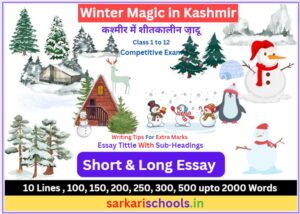Explore the enchanting world of Kashmir‘s winter magic through our insightful Essay On Winter in Kashmir. Delve into the captivating landscapes, snow-covered wonders, and the unique cultural tapestry that defines winter in Kashmir. Discover the charm of Srinagar’s frozen Dal Lake, the thrill of skiing in Gulmarg, and the tranquility of Pahalgam’s snow-kissed meadows. Our essay encapsulates the essence of Kashmir’s winter, blending natural beauty with cultural richness. Immerse yourself in the allure of this paradise on Earth and let the words paint a vivid picture of the winter wonder that is Kashmir. Read on to experience the poetic and magical journey of winter in the heavenly abode of Kashmir.
Table of Contents

Kashmir, often hailed as “Paradise on Earth,” is a region of breathtaking beauty nestled in the northern part of the Indian subcontinent. Characterized by snow-capped mountains, pristine lakes, and lush valleys, Kashmir has been a timeless muse for poets and travelers alike.
Brief Info About Kashmir
| Aspect | Description |
|---|---|
| Location | Northern region of the Indian subcontinent; part of the larger region of Jammu and Kashmir. |
| Geography | Diverse landscape featuring mountains, valleys, rivers, and lakes; renowned for the scenic beauty of the Himalayas. |
| Capital | Srinagar (summer), Jammu (winter); serves as the summer capital. |
| Famous Rivers | Jhelum, Chenab, and Indus flow through the region, contributing to its fertile plains. |
| Climate | Varied climate, ranging from sub-tropical in the plains to alpine in the mountains; four distinct seasons. |
| Languages | Urdu, Kashmiri, and Dogri are the main languages spoken; diverse linguistic and cultural heritage. |
| Religious Diversity | Significant populations of Muslims, Hindus, and Sikhs; diverse religious practices and festivals. |
| Tourist Attractions | Dal Lake, Gulmarg, Pahalgam, Shankaracharya Temple, Hazratbal Shrine; known for its breathtaking landscapes. |
| Economy | Mainly dependent on agriculture, horticulture, and handicrafts; also emerging as a tourist destination. |
| Political History | Historically a princely state, it acceded to India after independence, leading to territorial conflicts. |
| Conflict | Ongoing political tensions and conflicts over the region have been a longstanding issue. |
| Cultural Heritage | Rich cultural heritage with influences from Central Asian, Persian, and Indian cultures; vibrant arts and crafts. |
| Traditional Cuisine | Famous for Wazwan, a multi-course meal with various meat-based dishes; incorporation of saffron and dry fruits. |
| Natural Resources | Abundant in natural resources, including saffron, apples, and various medicinal plants. |
| Local Handicrafts | Renowned for Kashmiri carpets, Pashmina shawls, papier-mâché items, and intricately designed handicrafts. |
| Tourism Challenges | Periodic disruptions due to political tensions; efforts to promote sustainable tourism for economic development. |
- Essay on National Voters Day in English
- Essay on Importance of Fitness in English
- Essay On Holi in English For Class 1 to12
Srinagar, the summer capital, is renowned for its iconic Dal Lake, where houseboats gently sway on the water, creating a mesmerizing scene. The city’s Mughal gardens, adorned with vibrant flowers, reflect a rich historical heritage.
Gulmarg, transformed into a winter wonderland, draws skiing enthusiasts worldwide with its snow-covered slopes and panoramic vistas. Pahalgam, known as the “Valley of Shepherds,” offers serene landscapes, with the Lidder River meandering through lush meadows.
Kashmir’s cultural fabric is woven with diverse influences, creating a unique blend of Central Asian, Persian, and Indian traditions. The region’s handicrafts, from Pashmina shawls to intricate carpets, showcase the artistic brilliance of its people.
Season in Kashmir
| Aspect | Description |
|---|---|
| Season Duration | November to February |
| Weather | Extremely cold with temperatures often dropping below freezing. Snowfall is common. |
| Landscape | The valley transforms into a winter wonderland with snow-covered mountains, hills, and frozen lakes. |
| Tourist Activities | Skiing, snowboarding, ice-skating, and enjoying the snow-covered gardens like Shalimar Bagh and Nishat Bagh. |
| Festivals | Winter festivals celebrate Kashmiri culture with traditional music, dance, and delicious cuisine. |
| Dal Lake | Freezes during winter, providing opportunities for ice-skating and adding a unique charm to houseboats. |
| Adventure Sports | Popular for skiing; the snow-covered peaks attract adventure enthusiasts from around the world. |
| Traditional Warmers | Locals use traditional Kashmiri kangris (portable heaters) for warmth, adding to the cozy atmosphere. |
| Cultural Richness | Despite the cold, winter in Kashmir is a celebration of cultural richness and community spirit. |
| Challenges | Biting cold temperatures pose challenges, but the people exhibit resilience and warmth. |
| Unique Experience | Winter in Kashmir is not just a season; it’s an enchanting experience of nature, culture, and adventure. |
Despite political challenges, Kashmir stands resilient, captivating visitors with its natural allure and cultural richness. It remains an enchanting destination that lingers in the hearts of those fortunate enough to experience its ethereal charm.
10 Lines Essay On Winter in Kashmir
- Winter in Kashmir is a breathtaking spectacle of nature’s beauty.
- Snow-covered landscapes create a picturesque scene, turning the region into a winter wonderland.
- Traditional activities like skiing, ice skating, and snowboarding are an integral part of Kashmir’s winter culture.
- The extreme cold temperatures pose challenges to daily life, requiring locals to adapt and prepare.
- Special teas and culinary delights, unique to the winter season, add warmth and flavor to Kashmiri households.
- The wildlife in Kashmir faces a survival test during winter as animals navigate through the snowy terrain.
- Winter festivals and traditions add a festive charm, bringing communities together.
- Tourism flourishes in winter as visitors seek the enchanting beauty and engage in winter sports.
- The season’s challenges contribute to the resilience and adaptability of both people and wildlife.
- Winter in Kashmir is not just a season; it’s a cultural celebration and a testament to the region’s unique identity.
Winter in Kashmir Essay 100 words
Winter in Kashmir transforms the valley into a magical realm adorned with pristine snow. The landscape, veiled in white, captivates with its ethereal beauty. This season, from November to February, is marked by bone-chilling temperatures, often reaching sub-zero levels. Yet, the Kashmiris embrace the cold with warmth in their hearts. Traditional activities like skiing and snow festivals abound. The Dal Lake freezes, inviting ice-skaters and providing a surreal backdrop. Winter in Kashmir is not just a weather phenomenon; it’s a cultural celebration, a time when the valley’s beauty and the resilience of its people shine brightly, making it a unique experience for all.
Essay On Winter in Kashmir 200 Words
Winter in Kashmir is a season of enchantment and wonder. As the autumn leaves fall, the valley transforms into a winter wonderland, blanketed in a pristine layer of snow. The chill in the air announces the arrival of this magical season, typically spanning from November to February.
The snow-covered landscape turns Kashmir into a surreal painting, with majestic mountains, pine-covered hills, and iconic houseboats along the Dal Lake all draped in white. The famous gardens like Shalimar Bagh and Nishat Bagh wear a serene and frosty charm.
Despite the bone-chilling temperatures, Kashmiris welcome winter with open arms. The Dal Lake freezes, inviting locals and tourists alike to enjoy ice-skating and other winter sports. The vibrant winter festivals, featuring traditional music, dance, and delicious Kashmiri cuisine, add a cultural flair to the season.
The snow-capped peaks become a playground for skiing enthusiasts, attracting adventure seekers from around the world. The joyous atmosphere and the cozy warmth of traditional Kashmiri kangris (portable heaters) make winter a unique and unforgettable experience.
While the biting cold is a challenge, the people of Kashmir exhibit a remarkable resilience and warmth. Winter in Kashmir is not merely a weather phenomenon; it’s a celebration of nature’s beauty, cultural richness, and the indomitable spirit of its people.
Essay On Winter in Kashmir 500 Words
Introduction:
Nestled in the lap of the Himalayas, Kashmir, often referred to as “Paradise on Earth,” undergoes a breathtaking transformation during the winter season. As the temperatures drop, a blanket of snow covers the region, turning it into a winter wonderland. This essay delves into the magic of winter in Kashmir, exploring the landscape’s transformation, traditional activities, challenges faced, unique culinary delights, winter wildlife, and the impact of this season on tourism.
Landscape Transformation:
Kashmir’s winter is synonymous with enchanting landscapes. The pristine snow-capped mountains, frozen lakes, and charming villages blanketed in snow create a picturesque setting that captivates the beholder’s imagination. The region becomes a canvas of white, painting a serene portrait of natural beauty.
Winter Activities:
The winter season in Kashmir is not just about cold weather; it’s a celebration of life and culture. Locals and tourists alike engage in traditional winter sports and activities. Skiing, ice skating, and snowboarding are not just recreational pursuits but are deeply embedded in the cultural fabric of Kashmir. Winter festivals and local traditions add a festive charm to the season.
Challenges of Harsh Winters:
However, beneath the beauty lies the challenge of surviving the harsh winter. Extreme cold temperatures and heavy snowfall pose challenges to daily life and infrastructure. Transportation becomes difficult, and the need for adequate heating and shelter becomes paramount.
Unique Culinary Delights:
The Kashmiri winter is not just about the chill in the air but also about warming the soul with unique culinary delights. Special teas and beverages provide comfort, and traditional winter foods become a source of nourishment and warmth, showcasing the region’s rich culinary heritage.
Winter Wildlife:
While humans adapt to the winter chill, the wildlife faces its own set of challenges. Winter becomes a test of survival for many species. Animals navigate the snowy terrain, showcasing the resilience and adaptability of Kashmir’s diverse wildlife.
Impact on Tourism:
Paradoxically, winter’s challenges become a draw for tourists seeking unique experiences. The region’s winter tourism flourishes as visitors flock to witness the magical transformation and partake in winter activities. This seasonal influx significantly contributes to the local economy.
Conclusion:
In conclusion, the winter season in Kashmir is a symphony of nature, culture, and tradition. It transforms the region into a canvas of breathtaking beauty, offering a unique set of challenges and experiences. As Kashmiris navigate the cold, they celebrate their rich cultural heritage, and as tourists venture in, they become part of a magical winter tale. Winter in Kashmir is not just a season; it’s an experience that leaves an indelible mark on the hearts of those who embrace it.






